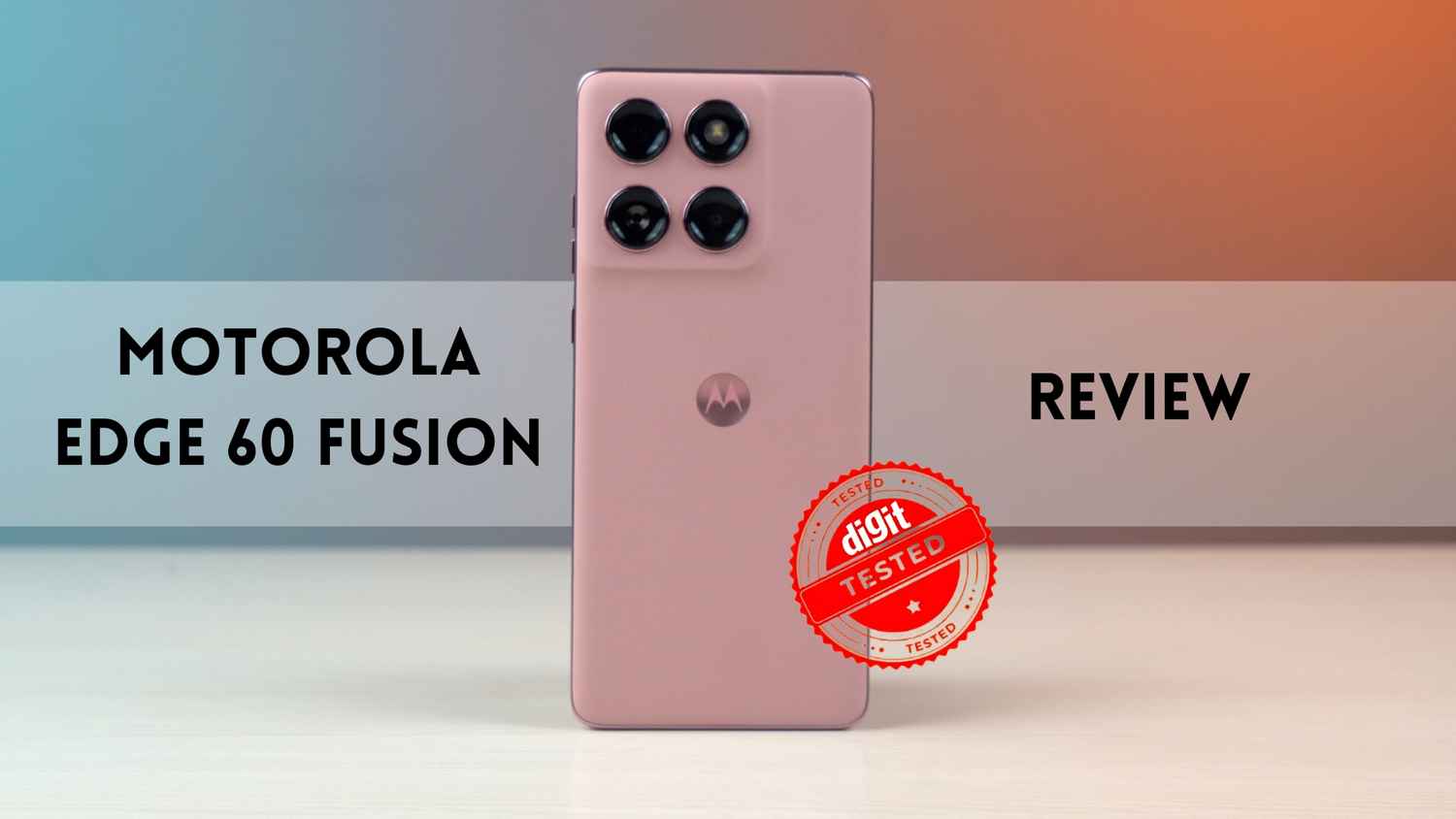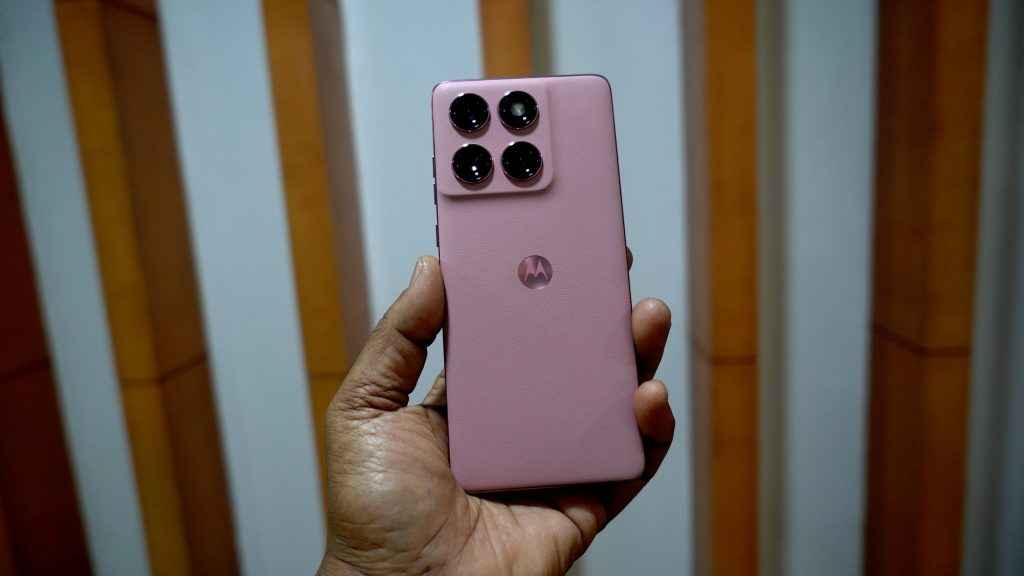

Motorola Edge 60 Fusion Review: The Edge 60 Fusion is Motorola’s first phone launch of 2025. The successor to last year’s Edge 50 Fusion (review), which was one of the highest-selling Edge-series phones, Motorola is looking to one-up that success with the Edge 60 Fusion, which has a lot going for itself. It stands out with its distinctive OLED display that curves on all sides, flush with a vegan leather finish on the back that gives it a premium feel.
Priced at ₹22,999, this successor to the Edge 50 Fusion brings several notable upgrades, including a higher resolution 1.5K display, improved Gorilla Glass 7i protection, and a larger 5500mAh battery. I spent a week with the Edge 60 Fusion, and I think it is a phone suited to most users, but not without its caveats.


The Edge 60 Fusion’s curved design really feels good in the hand. We get over 96% screen-to-body ratio which is impressive, and at 180 grams and 8.2 mm thickness, the phone feels substantial but not at all bulky. On the contrary, due to the quad curved panel, the phone feels quite lightweight and comfortable to hold.
We get faux vegan leather finishes in three Pantone colours: Slipstream, Amazonite and Zephyr. I like the Amazonite colour more since it has a canvas like texture, which feels quite different in the hand than the Zephyr variant.
This design gives it a distinct premium feel, and it’s a refreshing departure from the endless sea of glass-backed phones. That being said, the frame of the phone is plastic, but the build quality is solid, and you get an IP68/69 dust & water resistance rating.
One thing I noticed is that the Edge 60 Fusion arrives without a protective case in the box. When I reached out to Motorola about this curious omission, they explained it was a cost-cutting measure, claiming there’s enough third-party support for cases and skins these days.
While I understand the business point of view, my recommendation to them was to make their first-party cases available for purchase separately. Their official cases typically offer better fit and finish, and many users prefer matching their phone with accessories from the same brand.
The centerpiece here is the 6.67-inch quad-curved pOLED display, which is just excellent. It immediately stands out as soon as you take it out of the box, and with a 1.5K resolution, everything, be it text or videos, looks sharp and vivid.
The 120Hz refresh rate keeps everything smooth, though I should note this is a downgrade from the 144Hz refresh rate that you often get to see on Moto phones. The reason for that, Motorola says is that they got feedback where users were getting relatively lower screen on time and battery backup when the display was set to 144Hz at all times.
The display specs are impressive on paper, just short of Dolby Vision. It supports 10-bit color depth and HDR10+, and Motorola claims a peak brightness of 4500 nits for HDR content, while the regular high-brightness mode tops out at 1400 nits.
In our display tests using Portrait’s Calman and C6 Colorimeter, we found out that the Edge 60’s display is perfectly colour calibrated with an Average Delta E of 1 and 100% sRGB and DCI-P3 coverage, meaning it’s as good as it gets whether you’re scrolling social media or binging your favorite shows. The content always looks vibrant and immersive, and the display has a near-perfect RGB balance.
In our Display brightness tests, this display went up to 2400 nits of peak brightness in the Adaptive mode, which is respectable for outdoor visibility.
In comparison with the Edge 50 Fusion, the display resolution has been bumped up to 1.5K from FHD+, and you get Gorilla Glass 7i screen protection over Gorilla Glass 5.
The Edge 60 Fusion is powered by the Dimensity 7400 SoC, which is paired with 8 or 12GB of LPDDR4X RAM and 256GB UFS 2.2 storage. Bonus points to Moto for making the default storage 256GB, and while UFS 2.2 isn’t the fastest standard available, it is sufficient for most users. There’s also microSD expansion up to 1TB, which is becoming increasingly rare in mid-range smartphones.
In benchmarks, the Edge 60 Fusion lives up to its potential with a 20% uptick in AnTuTu and a 27% increase in the graphics performance in comparison to the Edge 50 Fusion. In the CPU throttling test, the phone showed minimal signs of throttling, which is decent, but as per our test labs, the Edge 50 Fusion performed around 10% better in this particular test.
In my daily use, I did not face any stutters or lags while opening or closing apps, switching between multiple apps like Instagram and Twitter and generally, the performance remained smooth in my time with it.
The MediaTek Dimensity 7400 is just fine. It’ll handle day-to-day tasks without complaints, but it’s not winning any benchmark championships. Power users or serious mobile gamers might find themselves wanting more headroom, in which case there are plenty phones in the sub-30k segment that focus on just offering raw performance for gamers.
We also have dual stereo speakers with Dolby Atmos support. There are two microphones for noise cancellation during calls, but like most modern phones, there’s no headphone jack.
In 2025, the omission of NFC is puzzling at best and deal-breaking at worst. It’s pretty much standard in this segment, but the Edge 60 Fusion doesn’t have NFC, which means you cannot use any tap-to-pay features.
Motorola’s approach to Android remains one of the cleaner implementations around. The Edge 60 Fusion runs Android 15 out of the box, with Motorola’s promise of three major OS updates and four years of security patches. This puts it slightly behind some competitors that offer longer support, but it’s still respectable. In fact, our review unit has already received the March Security update, and Motorola has gotten better with timely updates.
The Moto UI is fast and snappy and doesn’t come with a single bloatware app. Now, I’ve used a lot of these Android skins across different phones, and I feel Moto UI along with Nothing OS are two of the cleanest and freshest user interfaces on phones today, especially in this price segment.
We also get a ton of AI goodness with Moto AI like contextual search, notification summaries and Magic Canvas, but I really like the Remember This tool, which lets you save screenshots, photos and notes with context so that it reminds you later on.
In addition, Circle to Search is there, and we also get Quick Launch. Just double tap the back of the phone to launch the Moto AI dock. This can, of course, be customised to launch any app of your choice, take a screenshot, play music and more.
The camera system is headlined by a 50-megapixel main camera that uses Sony’s LYTIA 700C sensor with OIS. On paper, this is a solid setup and performs well, especially in challenging lighting conditions. Supporting this is a 13-megapixel ultrawide camera with a 120-degree field of view that also doubles as a macro camera. The third rear lens is actually not a camera but a 3-in-1 light sensor for ambient light detection, flicker reduction, and RGB colour sensing. For selfies, there’s a 32-megapixel front camera that bins down to 8MP for better light sensitivity. Video capabilities include 4K recording at 30fps or 1080p at 60fps from both front and rear cameras, along with several special modes like slow motion up to 240fps at 720p. There’s an auto enhance feature that uses AI to boost highlights, details and vibrancy but takes an extra 5-6 seconds to process the image. In daylight, the Edge 60 Fusion’s camera offers great performance with good details, colours and textures. The pictures look vibrant with natural-looking bokeh, and even in harsh light, the camera can balance saturation levels without overexposing highlights.
In low light, the Edge 60 Fusion performs even better as it retains close to natural colours and details, especially in shadow areas. The camera offers deeper and more natural blacks in pictures shot at night or in low-light conditions. Side by side comparison with the Nothing Phone 3a showed better detail retention and crisp visuals as opposed to softening around the edges.
In this picture, for example, you can see how the lavender colour flowers look bright and detailed on the Edge 60 Fusion, while on the Nothing Phone 3a, it looks diffused and doesn’t manage to accurately represent details. There are better highlight controls on the Edge 60 Fusion as opposed to the Phone 3a, which sometimes overcompensates on the processing front.
Battery life is a strong point with a large 5500mAh battery, which is a 500mAh increase from the Edge 50 Fusion. In my use, which included a lot of heavy lifting, juggling between multiple social media apps, watching videos, using Google Maps, a bit of gaming on the side and not to mention, the display being at 120Hz at all times, I got around 7-8 hours of screen on time easily.
In the PC Mark battery life test, the Edge 60 Fusion lasted for over 9 hours, which is a respectable score when it comes to daily use.
Motorola provides a 68W fast charger in the box, and using it, you can charge the Edge 60 Fusion from 0-100% in just about 48 minutes.
The Motorola Edge 60 Fusion is a complete package with some clear strengths in display and build quality, capable cameras, stable performance, clean software and dependable battery life. However, it also has some puzzling omissions, like NFC and a protective case in the box.
Starting at ₹22,999, the Edge 60 Fusion isn’t trying to be everything to everyone, but if you want a dependable performance, great viewing experience, clean and snappy software experience, this is the phone to buy for most users. However, if you want cutting edge raw performance, you game a lot and use NFC for contactless payments, you might want to swipe left on this one.